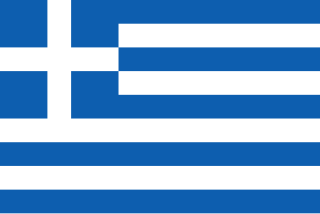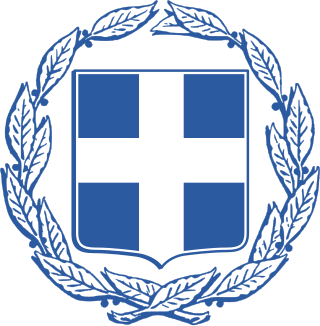
The national flag of Greece, popularly referred to as the "blue and white one" or the "azure and white", is officially recognised by Greece as one of its national symbols and has nine equal horizontal stripes of blue alternating with white. There is a blue canton in the upper hoist-side corner bearing a white cross; the cross symbolises Eastern Orthodox Christianity. The blazon of the flag is Azure, four bars Argent; on a canton of the field a Greek cross throughout of the second. The official flag ratio is 2:3. The shade of blue used in the flag has varied throughout its history, from light blue to dark blue, the latter being increasingly used since the late 1960s. It was officially adopted by the First National Assembly at Epidaurus on 13 January 1822. The nine stripes do not have any official meaning; the most popular theory says that they represent the syllables of the phrase Ελευθερία ή Θάνατος, the five blue stripes for the syllables Ελευθερία and the four white stripes ή Θάνατος. The nine stripes is also said to represent the letters of the word "freedom" . White and blue symbolise the colours of the Greek sky and sea.

A wreath is an assortment of flowers, leaves, fruits, twigs, or various materials that is constructed to form a circle.

The Crown Jewels of the United Kingdom, originally the Crown Jewels of England, are a collection of royal ceremonial objects kept in the Jewel House at the Tower of London, which include the coronation regalia and vestments worn by British monarchs.

St Edward's Crown is the centrepiece of the Crown Jewels of the United Kingdom. Named after Saint Edward the Confessor, versions of it have traditionally been used to crown English and British monarchs at their coronations since the 13th century.

The Imperial State Crown is one of the Crown Jewels of the United Kingdom and symbolises the sovereignty of the British monarch. It has existed in various forms since the 15th century. The 1937 version is worn by a new monarch for the first time in the royal procession following their coronation and subsequently used at State Openings of Parliament. The crown is adorned with 2,901 precious stones, including the Cullinan II diamond, St Edward's Sapphire, the Stuart Sapphire, and the Black Prince's Ruby.

The mitre or miter is a type of headgear now known as the traditional, ceremonial headdress of bishops and certain abbots in traditional Christianity. Mitres are worn in the Catholic Church, Eastern Orthodox Church, Oriental Orthodox Churches, the Anglican Communion, some Lutheran churches, for important ceremonies, by the Metropolitan of the Malankara Mar Thoma Syrian Church, and also, in the Catholic Church, all cardinals, whether or not bishops, and some Eastern Orthodox archpriests.

Moulding, or molding, also coving, is a strip of material with various profiles used to cover transitions between surfaces or for decoration. It is traditionally made from solid milled wood or plaster, but may be of plastic or reformed wood. In classical architecture and sculpture, the moulding is often carved in marble or other stones. In historic architecture, and some expensive modern buildings, it may be formed in place with plaster.

Papal regalia and insignia are the official items of attire and decoration proper to the Pope in his capacity as the visible head of the Catholic Church and sovereign of the Vatican City State.

The globus cruciger, also known as "the orb and cross", is an orb surmounted by a cross. It has been a Christian symbol of authority since the Middle Ages, used on coins, in iconography, and with a sceptre as royal regalia.

A cross pattée, cross patty, or cross paty, also known as a cross formy or cross formée, is a type of Christian cross with arms that are narrow at the centre, and often flared in a curve or straight line shape, to be broader at the perimeter. The form appears very early in medieval art, for example in a metalwork treasure binding given to Monza Cathedral by Queen Theodelinda, and the 8th-century lower cover of the Lindau Gospels in the Morgan Library. An early English example from the start of the age of heraldry proper is found in the arms of Baron Berkeley.

Danish Crown Regalia are the symbols of the Danish monarchy. They consist of three crowns, a Sceptre, Globus cruciger, the Sword of state and an Ampulla . The Danish Royal Regalia are kept in the treasury at Rosenborg Castle. The oldest of these is Christian III's sword of state from 1551. They further include King Christian IV's diamond; pearl- and gold-embroidered saddles; objects carved from ivory and rock-crystal; lapidary pieces of precious stones, and brooches in the form of fantastic animals.

The regalia of Norway are items that symbolise the Norwegian monarch's power and majesty. Little is known of the old Norwegian regalia which have since been lost. The majority of the modern regalia date from 1818 and were made for the coronation of Jean Bernadotte as King Carl III Johan.
A half-arch is the piece of gold, silver or platinum, usually decorated with jewels, that links the circlet of a hoop crown to the monde at the top of the crown.

The Imperial Crown of Austria is a crown formerly in use by the monarchs of the Habsburg monarchy. The crown was originally made in 1602 in Prague by Jan Vermeyen as the personal crown of Holy Roman Emperor Rudolf II, and therefore is also known as the Crown of Emperor Rudolf II. The crown was used as a private crown of the Holy Roman Emperors and Kings of Hungary and Bohemia from the House of Habsburg. In 1804 it became the official crown of the newly constituted Austrian Empire. After 1867 it remained the imperial crown of the Cisleithanian part of the Austro-Hungarian Empire until 1918.

The regalia of the Netherlands consists of a number of items symbolising the Dutch monarch's authority and dignity. In comparison to many European monarchies' regalia, the Dutch regalia are relatively new: having been commissioned by King William II in 1840. An earlier, more modest set of regalia made of silver was commissioned by King William I in 1815.

The coat of arms of Greece or national seal of Greece comprises a white Greek cross on a blue escutcheon, surrounded by two laurel branches. It has been in use in its current form since 1975. Prior to the adoption of the current coat of arms, Greece used a number of different designs, some of which were not heraldic; the first heraldic design was introduced in 1832 and its main element, the blue shield with the white cross, has been the base for all other national coats of arms since then. The design is a heraldic representation of the Greek national flag adopted in 1822, which featured a white cross on a blue field.

The Imperial Crown of Brazil, also known as the Crown of Dom Pedro II or as the Diamantine Crown, is the Crown manufactured for the second Brazilian Emperor, Pedro II.

The tradition of egg decoration in Slavic cultures originated in pagan times, and was transformed by the process of religious syncretism into the Christian Easter egg. Over time, many new techniques were added. Some versions of these decorated eggs have retained their pagan symbolism, while others have added Christian symbols and motifs.

Headgear, headwear, or headdress is any element of clothing which is worn on one's head, including hats, helmets, turbans and many other types. Headgear is worn for many purposes, including protection against the elements, decoration, or for religious or cultural reasons, including social conventions.

Regalia of the Russian tsars are the insignia of tsars and emperors of Russia, who ruled from the 13th to the 19th century. Over the centuries, the specific items used by Tsars changed greatly; the largest such shift occurred in the 18th century, when Peter the Great reformed the state to align it more closely with Western European monarchies.


















